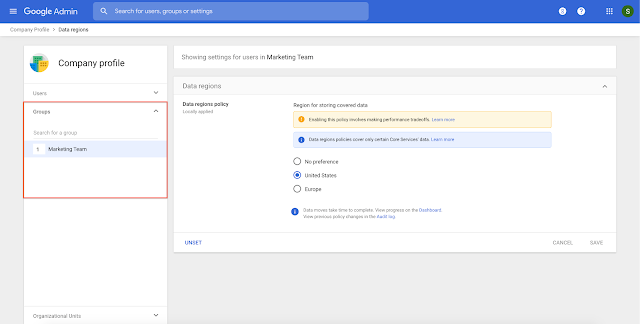What’s changing
Data regions allows G Suite customers to choose a specific geographic location for their covered data. We’re enhancing data regions with three key updates:- Coverage of user indices for Gmail and Calendar
- Coverage of Google Keep primary data at rest and backups
- More granular group-based controls
In addition to these new features, we’re also moving the location of the data region reporting dashboard from Admin Console > Dashboard to Admin Console > Reports > Data Regions.
Who’s impacted
AdminsWhy you’d use it
G Suite’s globally distributed cloud infrastructure reduces latency and protects data with geo redundancy. Therefore, most organizations choose not to geo-restrict their data. However, some organizations have preferences around where their data is stored at rest.To support those customers, we launched data region controls in 2018. Data regions lets customers designate the region in which covered data is stored when at rest—globally, in the US, or in Europe. Last year, we enhanced data regions with increased coverage of apps and data types.
By covering more apps, additional data types, and more granular admin controls, we hope to better support our customers’ data location preferences.
Additional details
Coverage of user indices for Gmail and Calendar
Gmail and Calendar construct user indices based on information in their accounts, similar to an index in a library, which lists information about all the books the library has available. This index is used to serve user search queries in Gmail and Calendar. These indices will now be covered by data regions. Once rolled out, index data for Gmail and Calendar will automatically be migrated to comply with existing data location policies. Use our Help Center to learn more about how to monitor data location move progress.
Gmail and Calendar user indices will now be supported
Coverage of Google Keep primary data at rest and backups
This addition extends data regions coverage to a total of 11 apps. Once rolled out, Keep’s primary data at rest and backups will automatically be migrated to comply with existing data location policies. Use our Help Center to learn more about how to track data location move progress.
More granular group-based controls
You can now set data regions for specific groups of users in your organization. You could previously only enable them by organizational unit (OU). This additional flexibility and control helps you use the feature without changing your organizational structure.
You can now control data region settings using groups
Getting started
Admins: Data location is OFF by default and can be enabled at the group or OU level. However, when it’s rolled out to your domain, Keep data and indices data for Gmail and Calendar will automatically be migrated to comply with any existing data location policies you’ve set up. Visit the Help Center to learn more about how to choose a geographic location for your data.
End users: There is no end user setting for this feature.
Rollout pace
- Rapid Release domains: Extended rollout (potentially longer than 15 days for feature visibility) starting on February 5, 2020.
- Scheduled Release domains: Extended rollout (potentially longer than 15 days for feature visibility) starting on February 5, 2020.
Availability
- Available to G Suite Business, G Suite Enterprise, and G Suite Enterprise for Education customers
- Not available to G Suite Basic, G Suite for Education, and G Suite for Nonprofits customers

